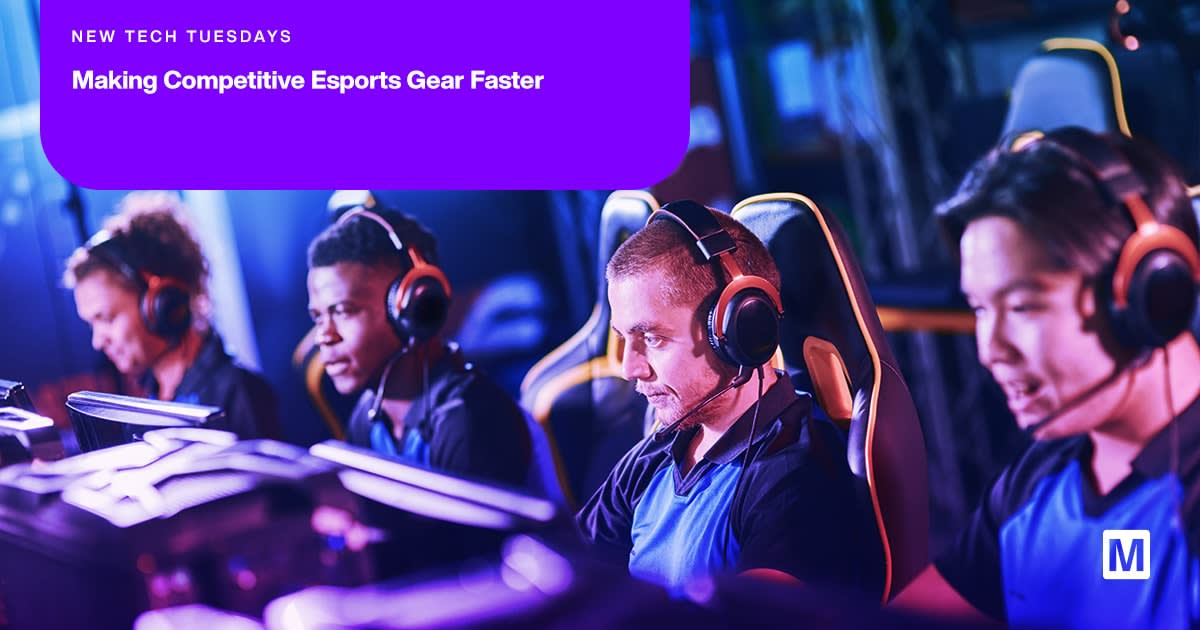Making Competitive Esports Gear Faster

New Tech Tuesdays
Join Mouser's Technical Content team for a weekly look at all things interesting, new, and noteworthy for design engineers.
Published October 7, 2025
Electronic sports (esports) used to be considered simply a hobby. Now, it’s a billion-dollar industry that attracts millions of viewers and big prize money.[1] The competition is so serious that it requires the same grade of engineering skills that were once considered aerospace-level. Professional gamers compete in environments where even the slightest lag can alter the outcome. Hardware designers working in this industry are required to rethink every component in competitive gaming peripherals, from keyboards and monitors to headsets and lighting.
This week’s New Tech Tuesdays looks at the tech behind the latest generation of esports hardware.
Designing for Low Latency
Esports hardware design is all about latency. When a gamer presses a key or clicks a mouse, that click needs to translate to on-screen action instantly (Figure 1). Engineers combine low-latency microcontrollers, rapid USB signaling, and polling rates at or above 1,000Hz to reduce delays.

Figure 1: Low-latency GPUs and 240Hz (or higher) monitors keep visuals synced with lightning-fast player reactions. (Source: DC Studio/stock.adobe.com)
Every click travels a path, and every part of that path can slow down its transmission. Engineers are working to make sure each link, from controller chips to connectors, moves without delay.
Polling rates play a big role in how responsive hardware feels. Most devices check inputs about 1,000 times per second, but top-tier peripherals now reach 8,000 checks per second.[2] That means the system has eight chances to catch each movement or click in the same amount of time, making missed inputs far less likely. To keep 8,000Hz stable, the firmware needs to be tight, the timing has to be solid, and the power system must be able to handle the load.
Where Engineering Meets Esports
As the esports industry demands faster and more precise hardware, gamers are experiencing some changes in their equipment. Engineers are giving a lot of attention to speed and reliability. For example, when it comes to input gear, Corsair’s K100 RGB keyboard runs at an 8,000Hz polling rate, delivering response times as low as 0.25ms for faster, more reliable keystrokes.[3] Razer’s Wolverine V3 Pro uses the same fast polling but adds magnetic joystick sensors that prevent drift—a problem that’s been common among traditional controllers for years.[4]
Displays are evolving, too. ASUS’s ROG Swift Pro PG248QP monitor reaches a 540Hz refresh rate, with response times under a millisecond, so visuals can keep up with even the fastest gameplay.[5]
Audio factors into low-latency, as well. ASUS’s ROG Pelta headset uses 2.4GHz wireless technology to keep sound in sync during gameplay.[6] Other manufacturers are developing chips that stream wireless audio with delays under 20ms, which is fast enough that players can react to what they hear without falling behind.
Durability also matters because controllers and joysticks take thousands of inputs in every match, and any wear can affect accuracy. Thrustmaster’s HallEffect AccuRate Technology (H.E.A.R.T.) controllers trade traditional parts for Hall-effect sensors that don’t wear down, eliminating joystick drift.[7] Even seating is changing, with companies like Cooler Master adding haptic feedback so players can feel the action as well as see it.[8]
The Newest Products for Your Newest Designs®
All these esports hardware innovations depend on high-bandwidth, low-latency data transfer. That demand makes network infrastructure just as important as the peripherals themselves. Lantronix has a new family of Power over Ethernet (PoE++) switches designed for speed, reliability, and flexibility.
Lantronix SM24TBT2DPB managed Gigabit PoE++ switches provide 24 Gigabit Ethernet ports with up to 90W of PoE++ per port, making them a good fit for Internet of Things (IoT) devices, smart building systems, and enterprise networks. Two 10GBase-X SFP+ uplink ports support high-speed backbone connections, while Layer 2 switching and advanced traffic management keep latency low. The switches also include built-in security, energy-efficient operation, and are easy to drop into existing networks. Powering high-wattage devices directly over Ethernet cabling reduces the need for separate power infrastructure and helps provide consistent performance in critical environments.
Tuesday’s Takeaway
Whether it’s faster inputs, sharper displays, or responsive audio, every esports advancement comes down to eliminating lag. This demand is what’s driving engineers to push polling rates higher, reduce panel latency, and refine wireless protocols to give gamers reliable control when they need it.
Sources
[1]https://sqmagazine.co.uk/esports-statistics-2
[2]https://www.windowscentral.com/gaming/pc-gaming/razers-new-wolverine-v3-pro-8k-kills-stick-drift-with-quantum-tunneling-tmr-is-it-overkill-or-a-gamers-dream
[3]https://www.corsair.com/us/en/p/keyboards/ch-912a014-na/k100-rgb-mechanical-gaming-keyboard-cherry-mx-speed-black-ch-912a014-na
[4]https://www.razer.com/newsroom/product-news/razer-wolverine-v3-pro-8k-pc/
[5]https://rog.asus.com/monitors/23-to-24-5-inches/rog-swift-pro-pg248qp
[6]https://rog.asus.com/headsets-audio/headsets/wireless-headsets/rog-pelta
[7]https://www.thrustmaster.com/en-us/products/heart-controller/
[8] D-BOX Gaming | Cooler Master Motion 1